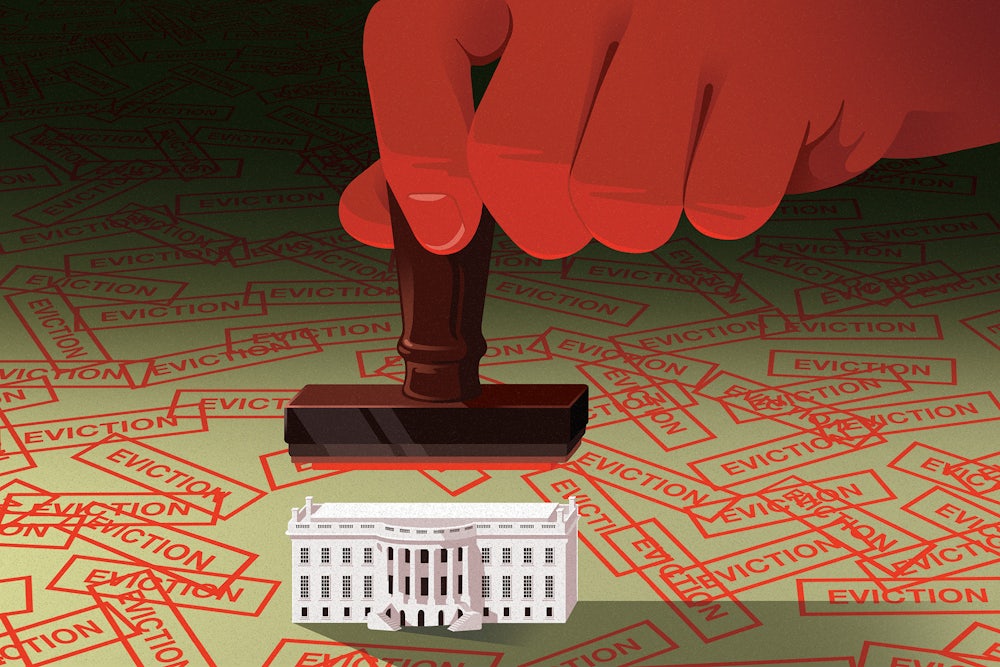One of the Biden administration’s most consequential housing policies is one practically nobody is talking about. It hasn’t been mentioned on the campaign trail, on social media, or by the White House, or even at all, outside of a dense Department of Housing and Urban Development press release and one brief quote in The Washington Post.
Even with little fanfare, the implementation of a 10 percent cap on rent increases for the 2.6 million apartments receiving funding from the Low-Income Housing Tax Credit, or LIHTC, represents a significant development in federal housing policy. Though far too high, the cap amounts to an embrace of rent control and—crucially—the president’s ability to advance it.
On housing, President Joe Biden has announced measures to target bad actors, increase supply, and boost new homeownership—policies with merit, but ones lacking the speed and scope to alleviate the rental crises faced by a massive chunk of Americans. For that, he must continue in the spirit of the LIHTC rent cap and go even bolder: fighting outright for rent control.
Rents are up over 20 percent since Biden took office. Renters comprise just over a third of all Americans, and more than half of those households (upward of 22 million) are now rent-burdened, meaning they pay over 30 percent of their income toward rent and utilities, according to the most recent data from the Joint Center for Housing Studies of Harvard University. Over 20 percent of renter households report severe rent burden, paying over 50 percent of their income in rent. Only 30 percent of renters say they can easily meet their housing costs, only slightly more than the 22 percent who report skipping meals in order to make their monthly payments. Meanwhile, homelessness is at an all-time high and evictions are surging. Rent, along with gas prices, accounted for over half of the increase in inflation just this March.
The persistence of high housing costs likely contributes to the mysterious “vibecession”—the gap between the economy’s relative strength (with low unemployment and high growth) and its weak public perception. A February survey from Redfin showed that housing affordability made nearly two-thirds of both homeowners and renters feel negatively about the economy, while 53 percent of Americans say housing affordability is shaping their electoral choice in November.
It’s no coincidence that the crisis most acutely hits the electoral demographics that Biden is struggling the most to win—nonwhite and young voters. Over 50 percent of Black and Hispanic renters suffer rent burdens, and, according to research from Zillow, 52 percent of Gen Z and 57 percent of millennial renters believe they would need to hit the lottery to be able to buy a home.
In response, the administration has sought to brand housing policy as “a key pillar of Bidenomics.” Recent speeches and media hits have highlighted the issue, and this year’s State of the Union broke new ground by directly addressing renters. Beyond messaging, the president has also pushed a number of small-scale housing programs.
In May 2022, the administration released a Housing Supply Action Plan, an assortment of no-cost new construction incentives. Seven months later, his administration turned to more immediate tenant issues, announcing a Blueprint for a Renters Bill of Rights, a nonbinding list of policy recommendations for local governments.
Last July, the administration announced concrete steps to ensure “all renters have an opportunity to address incorrect tenant screening reports,” and that they “are given fair notice in advance of eviction.” He also vowed his administration would fight rental “junk fees” and “crack down on big corporations” that price-fix rents, like RealPage, a software company that uses algorithms to coordinate mass-scale rent hikes. Most significant, limited as it may be, is of course the LIHTC rent cap, made official on April 1.
“It’s the first time that this administration, or any in recent history, has considered using a federal subsidy to introduce an annual rent cap,” said Tara Raghuveer, director of the National Tenant Union Federation and founder of KC Tenants, the citywide tenant union in Kansas City, Missouri. Due to the high cap, “It’s a partial win, but it is a materially significant one.”
Together the administration’s policies are positive steps. They also don’t do nearly enough to tame the rental crisis. Regulations like addressing unfair tenant screening practices and cracking down on algorithmic price-fixing are good but limited and fail to attack the core of the rental issue. “Of course, we want to look at bad actors, but we also can’t just assume that the only bad actors are ones that are using AI. There are plenty of landlords out there and property management systems who are egregiously increasing rents unrelated to RealPage,” said Tram Hoang, senior associate with national research group PolicyLink.
The country desperately needs more rental units priced for low-income tenants—the National Low Income Housing Coalition estimates the country is currently short 7.3 million affordable and available rental homes—but even if Biden’s proposed incentives for new construction passed Congress, it would be years until they make an impact. Even a supply-side success story like Minneapolis, which after incentivizing new construction has seen rent increases slow, only saw results after several years of construction, and mostly for the higher end of the market.
Home-buying assistance, meanwhile, suffers from a scope issue. Relatively meager tax credits may help some first-time buyers enter into the most popular version of housing cost control to ever exist: the 30-year mortgage. Good for them, but the tens of millions who remain renters need and deserve equally stable housing.
More than any other policy, the administration’s LIHTC rent cap points toward the possibility of immediate relief. Hoang sees the administration’s steps to cap rents in LIHTC buildings as a “sign of the Biden administration recognizing its power and using that power to regulate rents.” The logic of “we can regulate rents in buildings that get federal tax credits” can easily be extended.
The Biden administration can immediately extend that logic to the Federal Housing Finance Agency, or FHFA, which oversees Fannie Mae and Freddie Mac, the government-sponsored enterprises that do $150 billion worth of business with landlords a year.
“Many landlords’ business models are contingent on rent hikes: They’re overleveraged. They can’t pay down their mortgages unless they raise the rent and/or evict current residents,” said Raghuveer. “In many ways, Fannie and Freddie enable and encourage some of the worst practices in the real estate market. We want to see a uniform set of regulations, including rent caps, attached to Fannie and Freddie financing. If you benefit from federally backed financing, you should be subject to those terms.”
Whereas LIHTC covers 2.6 million apartments, the FHFA covers loans to over 12 million units, nearly a quarter of the country’s total rental housing stock. In a public comment period that closed last July, thousands of tenants along with 17 senators urged the FHFA to institute a 3 percent cap on these units. With the administration embracing immediate and retroactive caps on all LIHTC buildings, there is no excuse not to expand control to all federally financed landlords.
Conditioning FHFA loans would have a far-reaching impact. It is, crucially, something Biden can immediately implement unilaterally. And rent control works, now. It creates immediate stability and affordability with unrivaled speed and scale. It’s also cost effective—while it requires an administrative apparatus, it would be far cheaper than other proposals. Despite the protestations of Milton Friedman acolytes who famously denigrate it as “the fastest way to destroy a city, other than bombing,” studies have shown that rent control does not decrease housing production, as HUD noted in its LIHTC rent cap announcement, nor is it the chief cause of rent hikes in unregulated apartments.
“There are a lot of parallels to the minimum wage narrative—the majority of economists opposed it, and since then we’ve had an empirical revolution, the data now shows how minimum wage works,” Hoang explained. In evidence of that changing orthodoxy, more than 30 economists signed a letter to the FHFA backing rent control.
While a legislative push for national rent control (like Representative Alexandria Ocasio-Cortez’s A Place to Prosper Act) would be dead on arrival in Congress, a “messaging bill” could have legitimizing effects for local campaigns. Appointing a strong tenant advocate as HUD secretary could lead to bolder action on rent control and tenants’ rights. Most tangibly, an executive branch push for the policy, perhaps similar to the small, nonlegislative incentives promised to municipalities in the Housing Supply Action Plan, weak as they are, could have concrete effects—boosting ongoing rent control campaigns in 15 states, including key electoral targets like Arizona, Nevada, Georgia, Pennsylvania, and Michigan, all of which Biden won in 2020 by under 3 percent.
“Anything that’s being proposed in Congress right now does have an impact,” Hoang said. “There’s a feedback loop with these local and state campaigns and the federal government. [Federal action] gives credibility.”
Rent control is popular, too—a national poll in 2019 saw 58 percent of voters in favor, 17 percent against—and that’s before the Covid-supercharged spike in rent burden. The policy has even been backed by labor—like the powerful Culinary Union in Nevada—and also has racked up recent wins in purplish states like Maine and Minnesota, with similar efforts clearing the Colorado legislature. To win reelection, Biden desperately needs young voters and people of color to turn out in huge numbers, particularly in major cities in swing states like Michigan and Pennsylvania.
Voters like Teresa Diaz, a 67-year-old part-time medical research assistant in Detroit, whose out-of-state landlord proposed jacking up her rent nearly 30 percent, will help decide the 2024 election. Unable to afford moving costs and legally unprotected due to Michigan’s ban on rent control, she was able to negotiate it down to an increase of about 12 percent, but high housing costs are causing financial stress and contributing to her delayed retirement. Though Diaz plans to vote for Biden, even a small drop among tenants like her could jeopardize his success in the state.
Of course, the power of the real estate lobby is, as Biden might quip, “not a joke.” The National Association of Realtors alone spent $134 million on lobbying in 2022 and 2023. Sparking their ire in an election year could create internecine conflict within a party home to both big landlords and precarious tenants and is likely the reason the administration has stayed relatively quiet about the LIHTC rent cap thus far. But avoiding that conflict could be worse. “People are hurting, and some of their deepest pain is around rent. People need relief that they can feel when they pay their monthly bills. In an election year, this matters a lot,” said Raghuveer. “For too long, the real estate lobby has dominated every aspect of policymaking, buying the outcomes that maximize their profits.”
By embracing rent control, the president can portray himself as someone fighting for America’s working class in yet another battle against corporate greed. Even starker economic contrast with Donald Trump, the country’s most famous landlord, wouldn’t hurt either. And he wouldn’t be the first president to take this action. FDR and Harry Truman oversaw national rent control for much of the 1940s. Even Richard Nixon, facing high inflation and an unpopular, brutal proxy war, once implemented broad price controls, including a brief national rent freeze through the Cost of Living Council, or CLC, a now-defunct body headed at the time by Donald Rumsfeld.
Even contemporary critics credited it as a popular maneuver that helped tame inflation. As a conservative appointee (and critic) of the CLC wrote, “[Nixon] had dramatically turned the nation’s pessimism into short-term optimism, which established an image of action,” and after Nixon’s 1972 reelection, his opponent, Senator George McGovern, even said these controls were a significant reason why Nixon was “unbeatable.”
Ultimately, the concentrated power of private landlords over tenants creates a permanent state of insecurity that can only be truly alleviated by deep investments in alternative housing models, like that of Vienna, where over two-thirds of the population live in high-quality affordable public housing. Biden should look to recent proposals to increase supply of social housing, a model already successful and popular just outside D.C. But for immediate, widespread, effective policy, and savvy electoral politics, Biden now must heed the calls of organized tenants across the country, and turn to a tried, true, and popular policy: rent control.




